Background and context
The introduction of smart metering is one of the core elements in the European policies targeting competitiveness and environmental sustainability of energy markets. For more than a decade, EU Directives have been progressively setting the policy agenda for smart metering rollouts.
Already since 2009, in compliance with the provisions set out in the Third Energy Package, Member States were requested to proceed with the roll-out for a minimum of 80% of the electricity end-users by the year 2020, provided that the respective Cost-Benefit Analysis (CBA) provided a positive result.
In 2019, the “Clean Energy for all Europeans” encouraged smart metering roll-out in the the countries which had not completed the roll-out yet. Smart metering has been addressed in the Directive on common rules for the internal market in electricity (Directive (EU) 2019/944), revising the 2009 Directive. In Directive 2019/944, for the first time, it is underlined that the smart meter is a powerful tool, which however needs to be coupled with consumer energy management systems to deliver its benefits. Some new crucial aspects are also introduced regarding interoperability and data protection.
The overall successful roll-out of smart meters across the EU is dependent on criteria largely decided by Member States. This includes regulatory arrangements, and the extent to which the systems to be deployed will be technically and commercial interoperable, as well as guarantee data privacy and security. There is also no EU-wide consensus yet on the minimum range of operations required by smart meters.
Our role and contributions
- We carry out analyses on the smart meter roll-outs by the European Union countries via our DSO Observatory. The 2022 JRC DSO Observatory report shares results of a survey done by the JRC among European companies managing and operating electricity distribution grids. Technical and innovative features are presented, including on the adoption and use of smart meters.
- We also monitor smart metering uptake also in the Clean Energy Technology Outlook (CETO). The 2023 CETO Report on smart grids focuses inter alia on Smart Metering Infrastructure, and it discusses the current smart metering deployment status in terms of technology developments and trends, value chain analysis and global competitiveness.
- We also perform interoperability tests on smart meters, highlighting the importance of interoperability for the smooth operation of smart electricity systems.
- We jointly drafted with DG ENER the document "Benchmarking smart metering deployment in the EU-27 with a focus on electricity" as COM(2014)356. This report gauges progress in the deployment of intelligent metering in the EU Member States on the basis of economic assessments of long-term costs and benefits (CBAs) of electricity and gas smart metering prepared by Member States and submitted to the Commission in line with Third Energy Package provisions.
Main publications
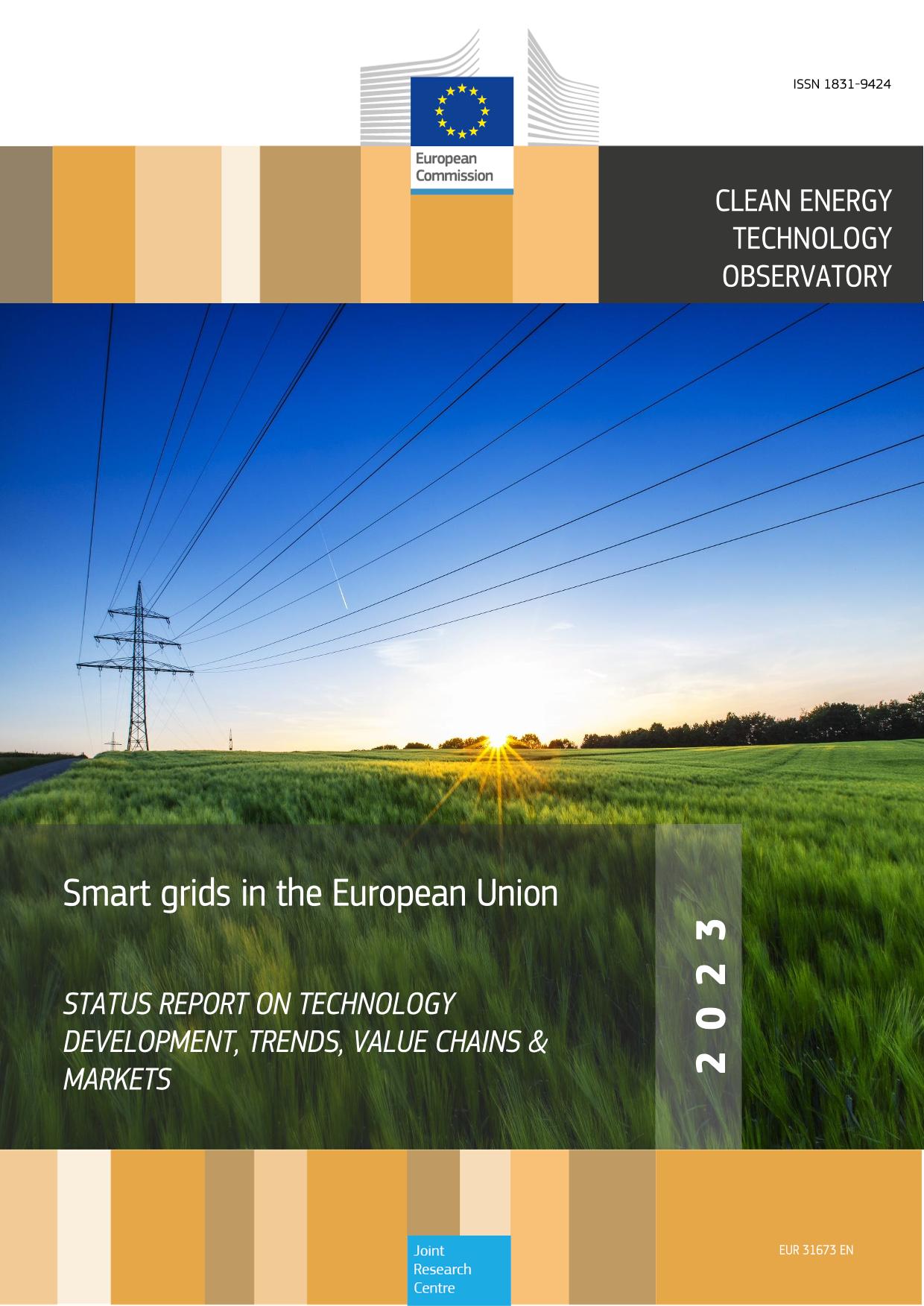
2023 - Clean Energy Technology Observatory: Smart Grids in the European Union - 2023 Status Report on Technology Development Trends, Value Chains and Markets
This document provides an overview of the latest technological and market trends on the topic of Smart Grids in the European Union. Given the broad scope of the topic, the analysis has focused on two fundamental enabling technologies: High Voltage Direct-Current (HVDC) connections and Smart Metering Infrastructure. The choice of analysing HVDC recognizes the fundamental role that the network infrastructure will play in the smooth integration of new renewable sources and in the support to an efficient operation of a decarbonized grid, whereas the focus on Smart Metering Infrastructure is meant to highlight its relevance in the upgrade of the energy grid, with numerous smart meter rollout plans worldwide. For each of these two topics, the current status is reported in terms of technology developments and trends, value chain analysis and global competitiveness.
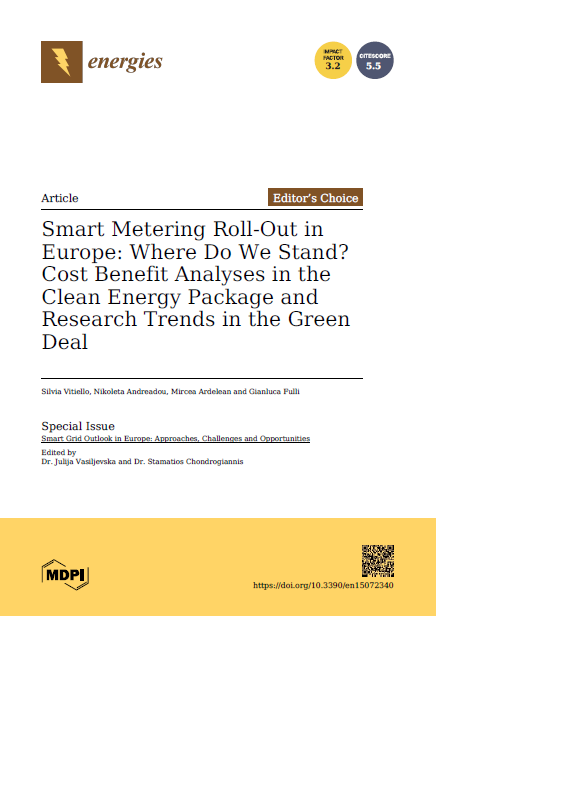
2022 - Smart Metering Roll-Out in Europe: Where Do We Stand? Cost Benefit Analyses in the Clean Energy Package and Research Trends in the Green Deal
2020 was a key year for several targets in European energy and climate policy, including the requirement for European countries to deploy smart metering for at least 80% of electricity consumers. In this paper, we analyze the initial provisions of the Third Energy Package and those of the Clean Energy Package, with particular focus on the recently approved directive on common rules for the internal market for electricity and the newly introduced smart meters specifications. We present the highlights of the national cost–benefit analyses for smart metering roll-out, focusing on the decisions made by the Member States with respect to a potential smart meter roll-out, that was targeted to be completed by 2020 and present the current situation of smart metering roll-out. We also present and categorize some of the R&I smart grid projects realized over recent years, focusing on the ones that deal with smart metering integration in order to depict the smart metering applications and technologies tested on the ground. Therefore, this paper portrays a full picture with respect to smart meters in Europe today and gives insights for monitoring smart metering roll-outs taking into account the current trends in smart metering applications.
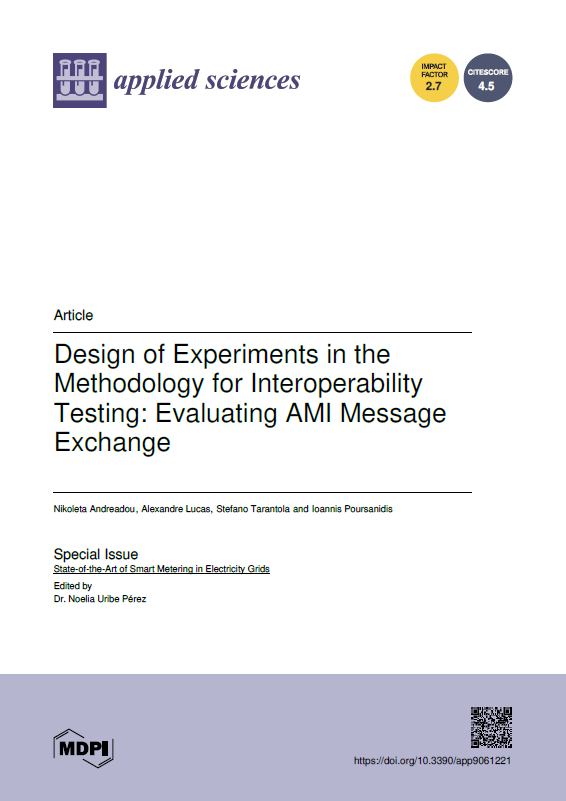
2019 - Design of Experiments in the Methodology for Interoperability Testing: Evaluating AMI Message Exchange
Interoperability is a challenge for the realisation of smart grids. In this work, we apply the methodology for interoperability testing and the design of experiments developed at the Smart Grids Interoperability Laboratory of the Joint Research Centre of the European Commission on a simple use case. The methodology is based on the Smart Grid Architecture Model (SGAM) of CEN/CENELEC/ETSI and includes the concept of Basic Application Profiles (BAP) and Basic Application Interoperability Profiles (BAIOP). The relevant elements of the methodology are the design of experiments and the sensitivity/uncertainty analysis, which can reveal the limits of a system under test and give valuable feedback about the critical conditions which do not guarantee interoperability. The design and analysis of experiments employed in the Joint Research Centre (JRC) methodology supply information about the crucial parameters that either lead to an acceptable system performance or to a failure of interoperability. The use case on which the methodology is applied describes the interaction between a data concentrator and one or more smart meters. Experimental results are presented that show the applicability of the methodology and the design of experiments in practice. The system is tested under different conditions by varying two parameters: the rate at which meter data are requested by the data concentrator and the number of smart meters connected to the data concentrator. With this use case example the JRC methodology is illustrated at work, and its effectiveness for testing interoperability of a system under stress conditions is highlighted.
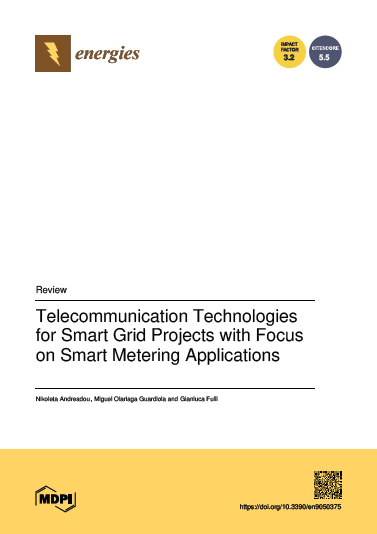
2016 - Telecommunication Technologies for Smart Grid Projects with Focus on Smart Metering Applications
This paper provides a study of the smart grid projects realised in Europe and presents their technological solutions with a focus on smart metering Low Voltage (LV) applications. Special attention is given to the telecommunications technologies used. For this purpose, we present the telecommunication technologies chosen by several European utilities for the accomplishment of their smart meter national roll-outs. Further on, a study is performed based on the European Smart Grid Projects, highlighting their technological options. The range of the projects analysed covers the ones including smart metering implementation as well as those in which smart metering applications play a significant role in the overall project success. The survey reveals that various topics are directly or indirectly linked to smart metering applications, like smart home/building, energy management, grid monitoring and integration of Renewable Energy Sources (RES). Therefore, the technological options that lie behind such projects are pointed out. For reasons of completeness, we also present the main characteristics of the telecommunication technologies that are found to be used in practice for the LV grid.
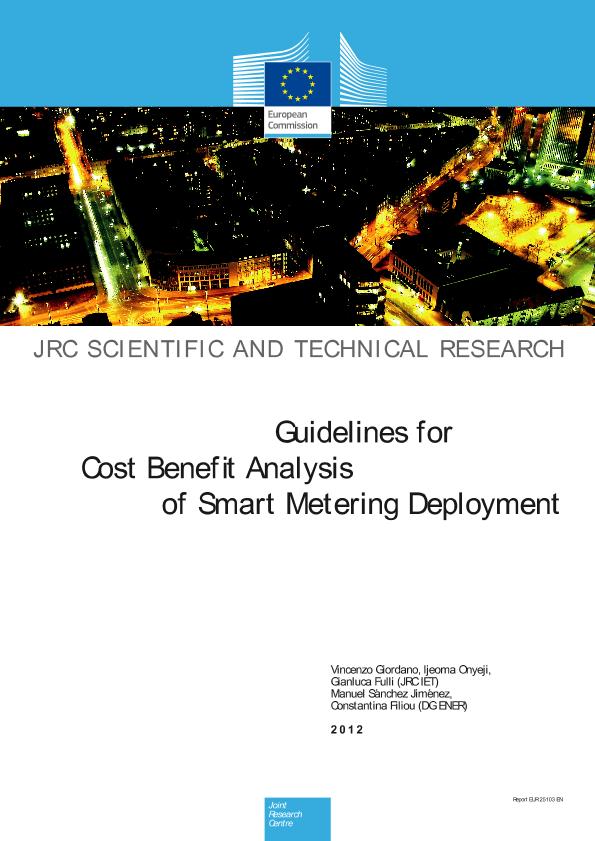
2012 - Guidelines for cost benefit analysis of smart metering deployment
The present document provides a methodological framework for conducting a cost-benefit analysis of smart meter deployment. The assessment framework is structured into a set of guidelines to tailor assumptions to local conditions, to identify and monetize benefits and costs, and to perform sensitivity analysis of most critical variables. It also provides guidance in the identification of externalities and social impacts that can result from the implementation of smart metering deployment but that cannot be easily monetized and factored into the cost benefit computation.
This document is mainly intended to support Member States in fulfilling the provisions of the 3rd Energy Package on CBA of smart metering deployment.
